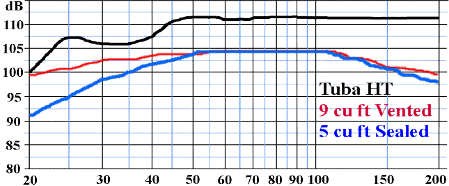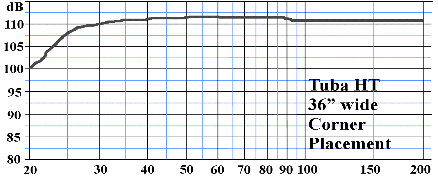And @kingharold , I noticed that the THT measurements are all corner loaded, hence 1/8 space and a 9db gain. Yet the website compares to Genelec readily available measurements which are 1/2 space, i.e. only 3db gain. Not exactly an apples to apples comparison.
My comment, so we are both being clear, was a 20Hz flat horn would be enormous. Your what appear to be 24" wide THT, as you said 18cu ft is not exactly "flat" to 20Hz (and of note the 1/2 the size vented catches up at 20Hz).

Even the large 27cu ft version is not flat to 20Hz. This is corner placed so maximum boundary reinforcement. It is not going to get better than this. If you had a vented 18cu sub, it would have a significant advantage in the deepest bass. This is an inherent issue with practical bass horns at least for home theater / effects. For a given size, they can’t reach as low as a vented box can. Better efficiency once you get past deep bass, but not as good for deepest bass. There have been designs that try to address that, but everything is a compromise. Fix one issue, create another.

Not that I would expect it to be by the way, just calling out hyperbole.
Now, you say the midranges are 16 feet from the bass? So I have to assume a much bigger listening room than most would be using? This is also implying that the cutoff for the woofers is above 80Hz? Your definition of midrange may not match what most people’s are. I will reserve judgement till you clarify, but if you are running the bass bins with any output past 120Hz, .... well better not to say anything.
@donavabdear , this brings up back to what you were saying about reflections and phase issues. Folded horns, if you have the space, can get some high efficiency and reasonably low distortion. Think of bass bins essentially. Keep the output below 100-120Hz, and phase issues aren’t a problem as we don’t detect even large group delay at those frequencies. Allow them to leak past 120Hz and other than the obvious locatable sub issue, the oscillating phase makes for audible group delay issues.

